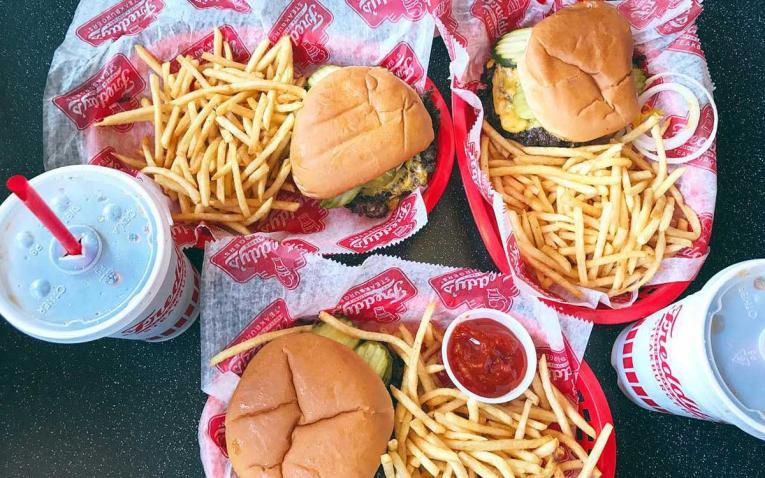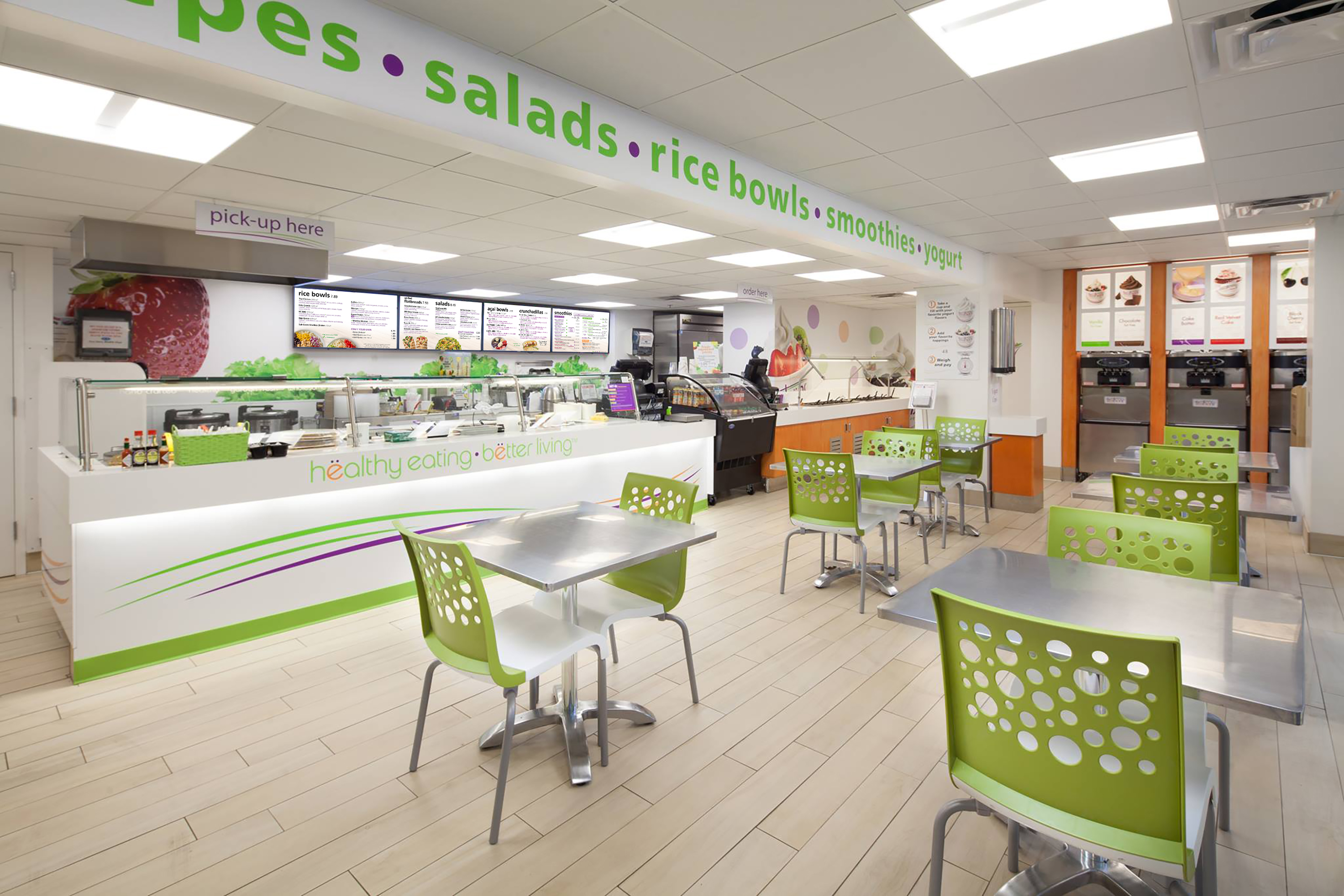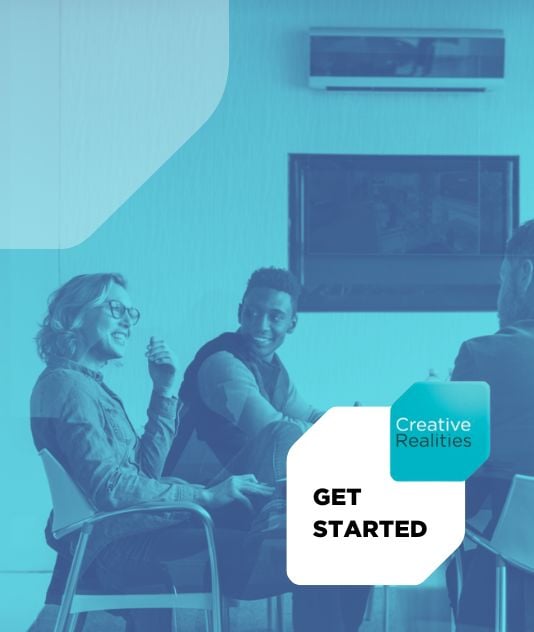Elevating the Guest Experience at Freddy's – and the role of IT as an Enabler
A chat with Sean Thompson, VP of IT at Freddy’s Frozen Custard & Steakburgers
Technology augments the best of what’s human. Creative Realities’ Beth Warren recently sat down to explore this concept with Sean Thompson, VP of IT at Freddy’s. Creative Realities supports the mission of Freddy’s by providing a data-driven design methodology to optimize their menu boards based on consumer behavior insights.
In the past two years alone, Freddy’s has seen remarkable growth thanks to leveraging an array of technology designed to enhance guest experience and optimize operations. Beth and Sean discuss these exciting developments and the ways technology can deepen points of connection between this QSR operator and its most valuable asset: its Guest.
BW: Sean, can you tell us a bit more about the exciting technology Freddy's has integrated into operations recently? What's the thing that's the most exciting for you right now?
ST: One of the most exciting things that we've integrated recently in terms of tech is in the kitchen. It's a piece of back-of-house technology that allows us to visually display orders as they come in.
If you went into the back of almost any restaurant in the past decade, there was always some system in place for the line cook to know what’s been ordered. We've all seen the speed rails at a diner. You have the window, the little notes of paper, a constant back-and-forth between waitstaff and the kitchen.
As technology matured, it didn't get much different than that. Printers at different stations were introduced, and eventually those printers evolved into screens; but those screens weren’t very sophisticated. They only gave the bare minimum in terms of what was ordered. All of this required a lot of reading of text on the part of the waitstaff, the cooks, everybody. If you’ve been in the back of a restaurant you know how fast things can move. It’s easy to scan something with your eyeballs and not really gather what you’re seeing in its entirety. The faster the rush, the more complex the order, the harder it is to keep orders straight. Or, on the flipside, you can become so accustomed to preparing an order in a certain way that you miss the nuance that occurs now and then.
So what we've added here at Freddy's is the ability for us to visually display what an order is. Now, when an order comes back to the kitchen, the line cook can look at a screen and see how it needs to be built visually. There’s an immediacy of comprehension that comes from this kind of symbolic representation that text just can’t quite replicate. You just look and do, look and do, look and do, and that allows you to go faster. It allows you to catch the specificity in an order, which allows us to better serve our guests.
We’ve taken this system over to the way that we bag out food, too. Using our visual system, we are now able to show the people whose job it is to bag the food exactly what goes in the bag, in exactly which order, exactly how much. This prevents wastefulness and it also elevates the guest experience: we’ve all gotten take out before where one small item comes packed in an enormous bag, or an entire meal is shoved into a tiny bag and it’s a disaster waiting to happen.
It might seem like a simple thing, but using this visual technology allows us to get more accurate on our orders, to go faster, to train quicker, and to have a better, calmer working experience. We’ll be rolling it out to our 500 locations over the next year and a half or so, and I know it’ll be an absolute game changer for us.
BW: I'm curious, are there any other forms of technology that you want to touch on historically that have had a massive impact on Freddy's operations up into the present day?
ST: We just recently celebrated a two-year anniversary of our point-of-sale conversion system. In any restaurant, the point of sale is that most critical piece of technology infrastructure. It’s the key to making sure everything a restaurant does technology-wise plays nicely together.
BW: What was the roll-out process like? What was your strategy?
ST: We went through an RFP and found a platform called PAR Brink. We did our first initial rollout over the course of three weeks, using 21 locations as our pilot. Then, four months later, we did another 400 locations. We did it fast because we knew it was a huge technology change that would enable us to do so much more—and we have. On the heels of that huge rollout, we’ve launched a new website and a new app, and we’ve seen huge improvements in our ability to integrate smoothly with third-party delivery apps. It’s also enabled us to run a first party help desk that’s gotten our response to ticket times on failed hardware down to 30 minutes tops.
BW: What’s been the biggest upside of embracing such a huge change in that relatively short amount of time?
ST: Don’t get me wrong, the change has had its stresses— but that’s just part of growth. Ultimately it's enabled us to have better integrations with accounting software, better integrations with our digital menu boards, and a better relationship with our guests. We couldn't have done our digital menu board integration that we have today if we wouldn't have made that change and if we hadn’t made it that quick. If we had taken a full year plus to roll out the new system, then we'd be a year behind where we are today in terms of technology rollout. And ain't nobody got time for that, so we went fast.
BW: Tell me more about how these new technology integrations have had an impact on guest experience.
ST: So when a guest comes into Freddy's and walks in the door or they pull up to a drive-thru, it's very important for us to present what you've come to Freddy's for. A menu, food—you're there to eat. We want to put our best foot forward with that, and to do that, we've leveraged technology. Partnering with you folks at Creative Realities is what’s allowed us to create a menu board experience that makes sense both for the guest and for our marketing purposes. It’s allowed us to tap into timeliness and context in a way like never before.
Whether it’s a guest’s first or thousandth time in Freddy's, I want them to know what's going on right now in a way that fits with everything else that we have there at the restaurant—it needs to be seamless and immediate. Part of Freddy's standard is that we don’t deal in dashed dreams. By that I mean, anything and everything we advertise across our channels at a given point in time is an accurate reflection of what’s available. There’s nothing worse than getting a hankering for something specific like cheese curds, walking up to a register and seeing that desired item on the menu, placing your order, and then having the store clerk say, “Oh, sorry, we actually don’t have any right now.” That’s an experience of pure let down that really sticks in a guest’s mind.
And so, whether the context is dine-in or drive-thru, our goal is to ensure that guests never feel let-down or led-on. Our menu boards reflect what’s available at any given time, and our guests have come to expect and trust that we will reliably serve them an excellent meal that satiates their desires.
Our success in guest satisfaction boils down to the fact that we’ve got all of our systems connected. Every employee, from cook to storefront to manager, knows what we’ve got in stock, what our specials are, and how essential our standard of service is. Dine-in or drive-through, that experience must be the same.

BW: Can you tell me about some improvements you’ve seen across locations since the launch of your digital menu boards?
ST: If we look at it from the guest level, that entails what we just discussed—providing guests a clear, concise way of seeing what's available at Freddy's.
From a restaurant level, things have gotten much more streamlined thanks to digital channels. Before, anytime there was a change in a product or a price, someone would have to go out and switch out these big Translite panels, which was no small task and took considerable time and manpower. Today, operators receive updates about product and price shifts instantaneously, thanks to being digitally connected. By making it digital, by making it connected, we're able to push these changes out quickly as a brand.
Restaurants are now able to conduct A-B and market testing more efficiently than ever before. We can say, "What happens if we remove this from the menu entirely?", and then retrieve that data and analyze it in a way that has a direct impact on sales. This ability to test, analyze, and pivot really empowers restaurants with the ability to not only stay ahead of the curve of guest appetite, but even set the tone for the guest appetite.
They can also look at the broader market and adjust easily based on what they’re seeing in terms of labor costs and product pricing. They're able to do that much quicker than they were able to do in the past.
BW: Sean, you’re an IT whiz. Can you talk to us about the networking side of things? What are retailers missing when they overlook the necessity of networking devices? So often I see people in retail overlooking this aspect of things.
ST: You’re right, people do often get a glossy look in their eyes the minute networking comes up. It’s not a sexy topic at first glance. But it’s really the nucleus of success. Whether it's in retail, hospitality, or health services, it doesn't matter - if you are in the operational or marketing sides of those industries, you know that connections are everything. And I’m not just talking about connections in a feel-good, relational, more intangible sense: I’m talking about the infrastructure itself. If you don’t have a solid core infrastructure, you’re not going to be able to create the kinds of experiences that lead to those higher level, brand-building, loyalty-inducing connections that companies run on.
A good IT network is something like having good manners. It’s possible to hold a conversation without using “please,” and “thank you,” but the absence of that additional level of care and conscientiousness will be felt. It’s a subtle thing, and we don’t get congratulated for remembering to be polite with others, but it actually makes a big difference in the impression we make. Similarly, when your digital infrastructure is strong, not only will the connections between your devices function efficiently, you’ll also wind up leaving a consistently great impression on your guests as a result of having that sturdy basis.
Freddy’s brand pillars are quality, cleanliness, and hospitality. Our ability to deliver on those pillars across 500 plus locations is directly related to the types of technologies we’re using to enhance operations, and the level of connection that exists amongst those various technologies.
BW: What challenges has Freddy’s faced in terms of balancing the integration of technology into operations and maintaining and fostering guest relationships?
ST: The best example of this is a COVID story. In January 2020, we had completed all the groundwork for launching Freddy's first mobile ordering system and were preparing for a March launch. But as COVID-19 restrictions began, our CEO let us know we couldn't launch due to the immediate challenges facing our restaurants, including beef shortages and managers spending hours securing supplies. It was very much a moment where technology meets reality head-on. As good as the technology was in that time, it wasn't in service of what the management team needed. The management team needed help with the very basics. So, we postponed the launch, reworked the training materials to be more manageable, and made the launch more gradual. This experience influenced our approach, leading to shorter, more concise training videos, ensuring messages are clear and quickly understood. This approach has guided our deployment of new technology and training processes ever since. It showed us to put the human element before the technological promise, in a way, and taught us how to approach integration in a more balanced manner.
BW: What’s something unique about Freddy’s approach to making all these pieces work together?
ST: I think one of the ways that Freddy's does technology differently than a lot of other companies is from our approach to IT support. One of the smartest things we’ve ever done as a company isn’t rolling out technology, it’s hiring people who know how to support technology. If something breaks or doesn’t go right, we own the process until it’s done. We’ve been very intentional about hiring staff who are equipped not just to manage people, but to also manage devices – people who can speak the language required to navigate those systems effectively. Our managers can call for support and there’s already a personal connection there with our IT team. That human personable connection is exactly what you need to smooth the gaps that have been created in a failure of technology.
BW: What is Freddy’s position on sustainability, both environmentally and in business?
ST: Environmental impact is very hard to understand in this industry. But at the most basic level, our approach is to make sure our food waste is low. And we serve quality ingredients, we serve them well – and that, to me, is a way of respecting what’s been created and giving it that full life cycle. And as much as I love IT, I'm also a farm boy. I'm from Kansas and I spent my summers on a farm, so I've always felt that good food that comes from good ingredients is what's worthwhile in life to consume.
From a business mindset, our approach has never been one of treating a Freddy's like a used car dealership. You don't fill out a form and somebody from our sales team slaps the hood of a Freddy's and says, "What can I do to put you in a Freddy's today?" That's not our mindset. Our mindset is to find franchisees that want to be entrepreneurs and partnerships in this growth, that want to be involved in the Freddy system. They're coming on board because they know we are doing things well and we want to continue to do well, and we want to do it with good partners. And so partnership has always been key for us, for that continued sustainable growth.
BW: Give us a sense of how you tackle ROI when pitching to leadership to fund technology-related investment spending.
ST: ROI is always a subject and source of heartburn yet a necessary reality for any commercial enterprise. he truth is, digital transformation isn’t cheap. It costs money, but in the long run, it makes money. But you do need to be able to show how it’s going to make that money, and sometimes that can be challenging. There are certain cases where the impact is obvious right up front: implement this and you’ll save this kind of money. But in other cases, the ROI isn’t as clear-cut. In those cases I focus on the direct benefits we can quantify-for example, increased efficiency, improved guest satisfaction, reduced downtime. I also break down the indirect advantages like enhanced brand reputation, better employee engagement, and the long-term competitive edge that digital transformation brings. Data and case-studies should be pulled in to support the points. You also need to be upfront about potential risks of not investing.
BW: How does Freddy’s stay relevant – both differentiated as a Brand experience but also in terms of the technology enablers you utilize?
ST: Freddy’s has had a distinct brand from the start: we’re not retro, we’re timeless. We fit in whatever the decade is because our pillars never change: quality, cleanliness, and hospitality. People wanted a clean, welcoming, quality place to eat a hundred years ago, and they want a clean, welcoming, quality place to eat now. We've just perfected it so that where you're eating actually is clean, is welcoming, and does offer quality food.
Technology is part of that equation for us. Some might think that the rapid evolution of technology signals the deterioration of brand identity; there’s a concern about how a business can keep up with new technologies while maintaining its identity. The key thing here is to embrace the changes brought on by technology but to keep your core, timeless values at the center. As long as we're changing something because it makes us better at achieving those core values, bring it on. If that means that in the near future everybody's coming into Freddy's with some kind of spatial computing device and augmented reality on their face, then we’ll figure out how to meet them there. We see all change as good change if it fits into our goal of presenting good food that ends as an actual experience of good food. the work that we do with our digital menu boards, it's going to look a lot different than it does in 2024. No matter what the technology is, it should just be a memorable experience for the guest. So the technology just weaves and plays its wonderful background music in that situation.
BW: Last question for you. If you had a “technology crush,” who would that be?
ST: Crush is a great word for this question, because our crushes are usually idealized projections, right? I think back to the crushes you get in high school where you knew the person you were sweet on was going to be perfect - they were funny, had a beautiful smile, and before you know it you’re head over heels for them. And then you maybe got to know them and you realized that your expectation didn’t match the reality. With all that in mind, my technology crush is on the dream girl version of Apple–and not necessarily what's true of the brand. This is a great example of the power of design. We fall in love with designs before we allow ourselves to connect with forms. Apple has a very specific design and that design directs everything they do, and they’ve been smart enough to lead with that. But they take it a step further – they make it easy to interact with the crush, with the design. Their philosophy is that the experience promised by the design should be easily accessible, whether you’re in the store or on the app. There should be a seamlessness and immediacy present across all channels.
Freddy’s is adopting a similar tactic. We’re changing the Freddy’s app such that whether they’re downloading our app or going to our website, users can quickly jump in and see the menu. Or, if a potential guest drives by a Freddy’s drive-thru, they’ll see our beautiful CRI-enabled digital menu boards. They won’t have to commit to us then and there, but they’ll see our design and will feel compelled to learn more–they’ll want to come back. It’s that idea, the idea that design drives everything, that I crush on when it comes to Apple.
BW: Sean, thank you for sharing these insights with us about the technological journey that’s been unfolding at Freddy’s over the past few years. How can our readers stay in touch with you and up-to-date on what’s happening at Freddy’s?
ST: Always a pleasure to talk with you, Beth. Readers can stay in touch by connecting with me on LinkedIn at https://www.linkedin.com/in/seanptdotcom/ and visiting Freddy’s online at https://www.freddys.com/.
Share this
You May Also Like
These Related Stories

Freddy's Builds Growth in Northeast Illinois | QSR magazine

Why and How We Put Smiles on Operators’ Faces at Freshëns



